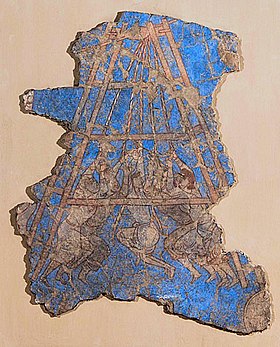
Back الفتح الإسلامي لما وراء النهر Arabic فتح ما وراء النهر ARZ موسلمانلارین اورتا آسیا آلینماسی AZB মুসলিমদের মাওয়ারাননহর বিজয় Bengali/Bangla Conquista musulmana de Transoxiana Spanish حمله مسلمانان به فرارود Persian Conquête musulmane de la Transoxiane French הכיבוש המוסלמי של טרנסאוקסאניה HE Penaklukan Transoxiana oleh Muslim ID Conquista islamica della Transoxiana Italian
| Muslim conquest of Transoxiana | |||||||||
|---|---|---|---|---|---|---|---|---|---|
| Part of the early Muslim conquests | |||||||||
 Mural depicting Arabs besieging the city of Samarkand, which was ultimately captured in 722 – Palace of Divashtich (706–722), Panjakent | |||||||||
| |||||||||
| Belligerents | |||||||||
|
| ||||||||
| Commanders and leaders | |||||||||

The Muslim conquest of Transoxiana, also called the Arab conquest of Transoxiana, was part of the early Muslim conquests. It began shortly after the Muslim conquest of Persia enabled the Arabs to enter Central Asia. Relatively small-scale incursions had taken place under the Rashidun Caliphate, but it was not until after the establishment of the Umayyad Caliphate that an organized military effort was made to conquer Transoxiana, a region that today includes all or parts of Uzbekistan, Tajikistan, Kazakhstan, and Kyrgyzstan. The campaign continued under the Abbasid Caliphate, and gradually saw the Islamization of the region.